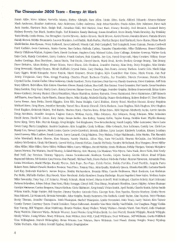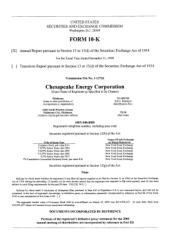Chesapeake Energy 1999 Annual Report Download - page 20
Download and view the complete annual report
Please find page 20 of the 1999 Chesapeake Energy annual report below. You can navigate through the pages in the report by either clicking on the pages listed below, or by using the keyword search tool below to find specific information within the annual report.
Company nor, to its knowledge, its predecessors or successors have been named a potentially responsible party under
CERCLA or similar state superfund laws affecting property owned or leased by the Company.
Air Emissions. The operations of the Company are subject to local, state and federal regulationsfor the control
of emissions of air pollution. Legal and regulatory requirements in this area are increasing, and there can be no
assurance that significant costs and liabilities will not be incurred in the future as a result of new regulatory
developments. In particular, regulations promulgated under the Clean Air Act Amendments of 1990 may impose
additional compliance requirements that could affect the Company's operations. However, it is impossible to predict
accurately the effect, if any, of the Clean Air Act Amendments on the Company at this time. The Company may in
the future be subject to civil or administrative enforcement actions for failure to comply strictly with air regulations
or permits. These enforcement actions are generally resolved by payment of monetary fines and correction ofany
identified deficiencies. Alternatively, regulatory agencies could require the Company to forego construction or
operation of certain air emission sources.
OSHA. The Company is subject to the requirements of the federal Occupational Safety and Health Act
("OSHA") and comparable state statutes. The OSHA hazard communication standard, the EPA community right-to-
know regulations under Title III of the federal Superfund Amendment and Reauthorization Act and similar state
statutes require the Company to organize information about hazardous materials used, released or produced in its
operations. Certain of this information must be provided to employees, state and local governmental authorities and
local citizens. The Company is also subject to the requirements and reporting set forth in OSHA workplace
standards. The Company provides safety training and personal protective equipment to its employees.
OPA and Clean Water Act. Federal regulations require certain owners or operators of facilities that store or
otherwise handle oil, such as the Company, to prepare and implement spill prevention control plans, countermeasure
plans and facilities response plans relating to the possible discharge of oil into surface waters. The Oil Pollution Act
of 1990 ("OPA") amends certain provisions of the federal Water Pollution Control Act of 1972, commonly referred
to as the Clean Water Act ("CWA"), and other statutes as they pertain to the prevention of and response to oil spills
into navigable waters. The OPA subjects owners of facilities to strict joint and several liability for all containment
and cleanup costs and certain other damages arising from a spill, including, but not limited to, the costs of
responding to a release of oil to surface waters. The CWA provides penalties for any discharges of petroleum
product in reportable quantities and imposes substantial liability for the costs of removing a spill. State laws for the
control of water pollution also provide varying civil and criminal penalties and liabilities in thecase of releases of
petroleum or its derivatives into surface waters or into the ground. Regulations are currently being developed under
OPA and state laws concerning oil pollution prevention and other matters that may impose additional regulatory
burdens on the Company. In addition, the CWA and analogous state laws require permits to be obtained to authorize
discharges into surface waters or to construct facilities in wetland areas. With respect to certain of its operations, the
Company is required to maintain such permits or meet general permit requirements. The EPA has adopted
regulations concerning discharges of storm water runoff. This program requires covered facilities to obtain
individual permits, participate in a group permit or seek coverage under an EPA general permit. The Company
believes that with respect to existing properties it has obtained, or is included under, such permits and with respect to
future operations it will be able to obtain, or be included under, such permits, where necessary. Compliance with
such permits is not expected to have a material effecton the Company.
NOR]vi Oil and gas exploration and production activities have been identifiedas generators of concentrations of
low-level naturally-occurring radioactive materials ("NORM"). NORM regulations have recently been adopted in
several states. The Company is unable to estimate the effect of these regulations, although based upon the
Company's preliminary analysis to date, the Company does not believe that its compliance with such regulations will
have a material adverse effect on its operations or financial condition.
Safe Drinking Water Act. The Company's operations involve the disposal of produced saltwater and other
nonhazardous oilfield wastes by reinjection into the subsurface. Under the Safe Drinking Water Act ("SDWA"), oil
and gas operators, such as the Company, must obtain a permit for the construction and operation of underground
Class II injection wells. To protect against contamination of drinking water, periodic mechanical integrity tests are
often required to be performed by the well operator. The Company has obtained such permits for the Class II wells
-10-
























